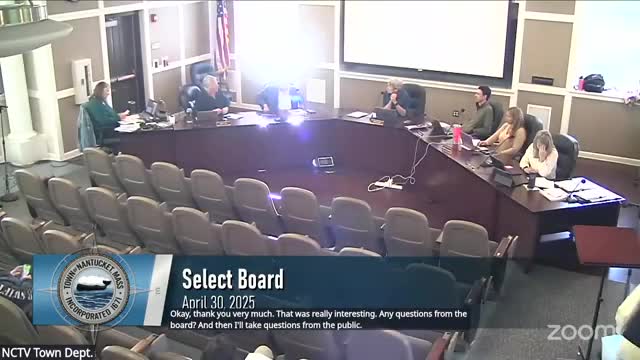NSF scientists detail aquifer drilling project amid Nantucket water quality concerns
January 03, 2025 | Nantucket County, Massachusetts
This article was created by AI summarizing key points discussed. AI makes mistakes, so for full details and context, please refer to the video of the full meeting. Please report any errors so we can fix them. Report an error »

Concerns over environmental safety took center stage during the Nantucket Select Board meeting on April 30, 2025, as community members voiced apprehensions about a proposed scientific drilling project. The project aims to study freshwater aquifers beneath the ocean, but residents are worried about potential impacts on Nantucket's fragile ecosystem and water supply.
Key discussions highlighted that the drilling is not expected to encounter oil, gas, or rare earth minerals, as confirmed by scientists involved in the project. They emphasized that the geology of the area does not support such resources, focusing instead on understanding the origins of freshwater in the sediments beneath the ocean. Chief scientist Brandon noted that the project is part of a global initiative to address water scarcity, but he clarified that the immediate goal is purely scientific.
Residents raised pointed questions about the environmental implications of the drilling, particularly in light of recent issues with the Vineyard Wind Project, which has faced scrutiny due to a catastrophic blade collapse. Concerns were expressed about the potential contamination of Nantucket's sole freshwater supply, especially given past incidents of PFAS contamination in local wells.
In response, project representatives assured the community that the drilling would involve minimal discharge of environmentally friendly materials and that any impacts would be closely monitored. They stated that the boreholes created during the drilling would naturally collapse, reducing the risk of long-term contamination. However, residents remained skeptical, questioning the adequacy of environmental assessments and the project's timing during the busy summer season.
The meeting underscored a growing tension between scientific exploration and community concerns over environmental protection, with residents calling for greater transparency and assurance that their natural resources would not be compromised. As the project moves forward, the Select Board will continue to engage with both the scientific team and the community to address these critical issues.
Key discussions highlighted that the drilling is not expected to encounter oil, gas, or rare earth minerals, as confirmed by scientists involved in the project. They emphasized that the geology of the area does not support such resources, focusing instead on understanding the origins of freshwater in the sediments beneath the ocean. Chief scientist Brandon noted that the project is part of a global initiative to address water scarcity, but he clarified that the immediate goal is purely scientific.
Residents raised pointed questions about the environmental implications of the drilling, particularly in light of recent issues with the Vineyard Wind Project, which has faced scrutiny due to a catastrophic blade collapse. Concerns were expressed about the potential contamination of Nantucket's sole freshwater supply, especially given past incidents of PFAS contamination in local wells.
In response, project representatives assured the community that the drilling would involve minimal discharge of environmentally friendly materials and that any impacts would be closely monitored. They stated that the boreholes created during the drilling would naturally collapse, reducing the risk of long-term contamination. However, residents remained skeptical, questioning the adequacy of environmental assessments and the project's timing during the busy summer season.
The meeting underscored a growing tension between scientific exploration and community concerns over environmental protection, with residents calling for greater transparency and assurance that their natural resources would not be compromised. As the project moves forward, the Select Board will continue to engage with both the scientific team and the community to address these critical issues.
View full meeting
This article is based on a recent meeting—watch the full video and explore the complete transcript for deeper insights into the discussion.
View full meeting
